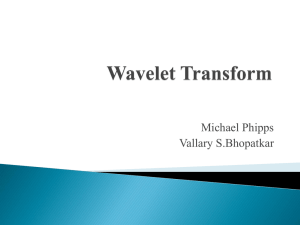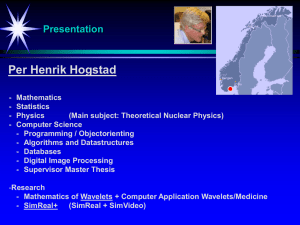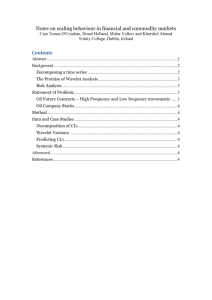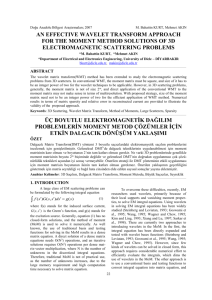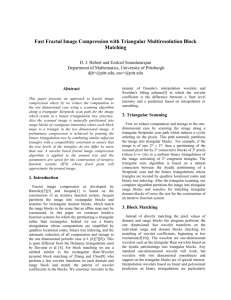- Krest Technology
advertisement
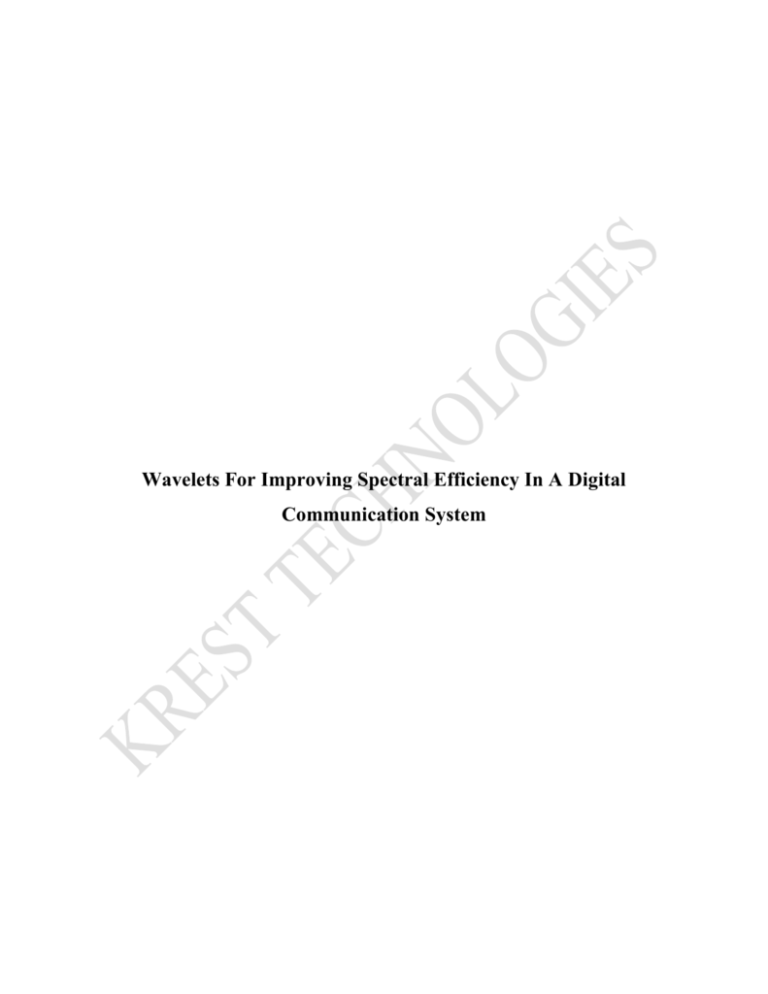
Wavelets For Improving Spectral Efficiency In A Digital Communication System Abstract In this paper, two types of wavelet based schemes to improve the Spectral Efficiency (SE) of a digital communication system are presented. First one is wavelet based pulse shaping and the other is Wavelet based digital modulation called Wavelet Shift Keying (WSK). In pulse shaping scheme, orthonormal wavelets and their translates are used as base band shaping pulses .To improve spectral efficiency and coding gain, dyadic expansions and their translates are used for signaling. Since wavelets have zero average value, they can be transmitted using Single SideBand (SSB) transmission. By comparing with Raised-Cosine (RC) signaling, this wavelet approach offers more data rate at the same bandwidth. RC system offers only 0.83 b/S/Hz for low pass transmission where as transmission using the first two dyadics offers 1.12 b/S/Hz. More over, it is shown that wavelets obey Nyquist pulse shaping conditions. Using a dyadic expansion to support a channel code there is a coding gain over the RC system, with essentially no bandwidth penalty. In Modulation scheme, the user data stream is transformed into sequence of scaled mother wavelets to indicate which version of the mother wavelet is transmitted. This modulation offers more Spectral Efficiency as number of users increases keeping the power efficiency as constant. Key words - Pulse shaping, Wavelets, Dyadics, Modulation, Power Spectral Density, Spectral Efficiency, Probability of error. 1. Introduction Wavelets have recently become very popular in many different scientific fields, including signal processing. A wavelet is a signal or waveform having desirable characteristics such as localization in time and frequency, and orthogonality across scale and translation. Wavelets appear to be promising waveforms due to its inherent orthonormality property [1][2]. Motivation for the use of wavelets for pulse shaping stems from the fact that Nyquist pulseshaping criterion is satisfied by wavelets and scaling functions and also the development of Bi-orthogonal RC wavelets [3]. In fact, it turns out that the band limited RC waveforms are scaling functions of a special class of Meyer wavelets [4]. For WSK, the motivation came from the compact support of the orthonormal wavelets when compared to the pulsed sinusoid as in conventional keying. 2. Objective Communication system that uses wavelets as the orthonormal basis for pulse shaping and modulation are derived. The pulse-shaping scheme can be used in a traditional PAM system to increase the spectral efficiency. The wavelet used in this paper is spectrally compact to most other wavelets found in the literature. The energy per bit remains the same when the data streams are overlapped, since each wavelet is an orthonormal function. In Conventional systems overlapping of data causes the energy per bit must be increased. Hence the proposed system is an efficient one in conserving bandwidth and power, the two important communication resources. 3. Problem definition: The wavelet used for pulse shaping scheme is used here as a keying waveform. As seen from Figure WSK offers a 38 dB side lobe reduction in the absence of filtering. Also the side lobes are very far from the frequency of transmission when compared to BPSK and CPM, which has large number of reduced side lobes. Even though WSK offers a very good side lobe reduction the bandwidth required for transmission seems to be large compared with BPSK and CPM. 4. Proposed scheme Digital signals need to be modulated before they can be transmitted through an analogue communication channel [10]. Several coherent and non-coherent modulation waveforms have been devised for transmitting binary information over pass band channels. Common signaling schemes for transmitting digital information over band pass channels are based on a perpetual carrier wave. Wavelets have been adopted with success in many practical situations to replace sinusoidal waveforms. It seems to be somewhat expected a replacement of a classical oscillator by a waveform generator that produces a basic mother wavelet. This kind of modulation approach named Wavelet Shift Keying (WSK) and this section demonstrate the scheme. The modulator block diagram WSK is shown in Figure 5. In the basic schemes, input binary string is converted into a stream of scale values that control the keying. The mother wavelet is locally generated and every scaled version is derived in a scaling layer. The notation X1, X2... XM specifies the scaling factor. 5. Software and hardware requirements Operating system : Windows XP/7. Coding Language : MATLAB Tool : MATLAB R 2012 System requirements: Hardware requirements: System : Pentium IV 2.4 GHz. Hard Disk : 40 GB. Floppy Drive : 1.44 Mb. Monitor : 15 VGA Colour. Mouse : Logitech. Ram : 512 Mb. 6. Conclusion This wavelet system can be used to increase the data rate while maintaining performance, or to increase the performance while maintaining a given data rate by accommodating a channel code using one dyadics without any bandwidth expansion. The WSK modulators proposed here can be used in the place of conventional modulators to increase the spectral efficiency. This modulator shows a very good spectral efficiency even without transmit filtering. When compared to the BPSK and CPM this WSK offers better spectral efficiency as number of users increased. The AWGN performance of the system coincides with that of BPSK. In order to utilize WSK as a practical signaling strategy, other key properties of the waveform such as performance in a fading channels and synchronization aspects must be quantified. These are the future areas to be explored. References [1] W. Jones, “A unified approach to orthogonally multiplexed communication using wavelet bases and digital filter banks,” Ph.D. dissertation, Ohio Univ, Athens, Aug 1994. [2] Fred Daneshgaran and Marina Mondin, “Bandwidth efficient modulation with wavelets”, IEEE Electronics letters, Vol.30 No.15, pp. 1200-1202, July 1994. [3] J. N. Livingston and C. Tung, "Bi-orthogonal raised-cosine wavelets”, Electronics Letters, vol. 31, no. 6, pp. 438 - 439, March 1995. [4] W. Jones and C. Dill, “The square root Raised Cosine Wavelet and its relation to the Meyer function”, IEEE Trans. Signal Processing, Vol. 49,no.1, 248-251,Jan 2001. [5] M.Vetterli and C.Herley, “Wavelets and filter banks: Theory and Design”, IEEE Trans. Signal Proc, vol. 40, no. 9, Sept. 1992. [6] I. Deubechies,“Ten Lectures on Wavelets”, CBMF-NSF 61, Regional Conf series in applied math, 1992. [7] S.Mallat, “A Theory Of multi resolution signal decomposition: the wavelet representation “, IEEE Trans. Pattern Anal. Machine Intell, vol II,, pp. 674-693, July 1989


